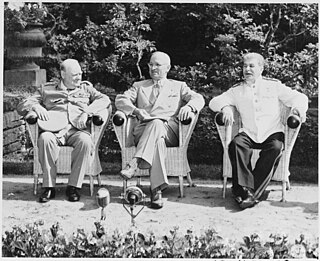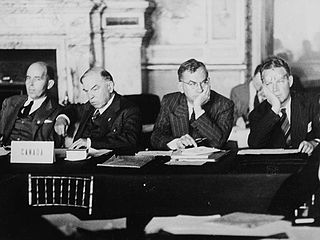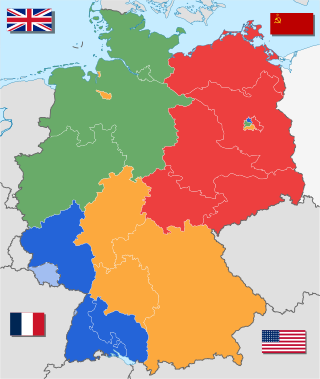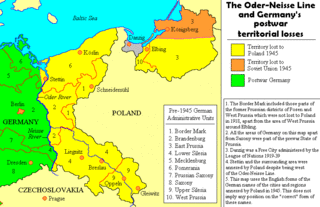Related Research Articles

The Potsdam Conference was held at Potsdam in the Soviet occupation zone from July 17 to August 2, 1945, to allow the three leading Allies to plan the postwar peace, while avoiding the mistakes of the Paris Peace Conference of 1919. The participants were the Soviet Union, the United Kingdom, and the United States. They were represented respectively by General Secretary Joseph Stalin, Prime Ministers Winston Churchill and Clement Attlee, and President Harry S. Truman. They gathered to decide how to administer Germany, which had agreed to an unconditional surrender nine weeks earlier. The goals of the conference also included establishing the postwar order, solving issues on the peace treaty, and countering the effects of the war.

The Potsdam Agreement was the agreement among three of the Allies of World War II: the United Kingdom, the United States, and the Soviet Union after the war ended in Europe on 1 August 1945 and it was published the next day. A product of the Potsdam Conference, it concerned the military occupation and reconstruction of Germany, its border, and the entire European Theatre of War territory. It also addressed Germany's demilitarisation, reparations, the prosecution of war criminals and the mass expulsion of ethnic Germans from various parts of Europe. France was not invited to the conference but formally remained one of the powers occupying Germany.

The Paris Peace Treaties were signed on 10 February 1947 following the end of World War II in 1945. The Paris Peace Conference lasted from 29 July until 15 October 1946. The victorious wartime Allied powers negotiated the details of peace treaties with those former Axis allies, namely Italy, Romania, Hungary, Bulgaria, and Finland, which had switched sides and declared war on Germany during the war. They were allowed to fully resume their responsibilities as sovereign states in international affairs and to qualify for membership in the United Nations. Nevertheless, the Paris Peace Treaties avoided taking into consideration the consequences of the Molotov–Ribbentrop Pact, officially known as the Treaty of Non-Aggression between Germany and the Union of Soviet Socialist Republics, whose secret clauses included the division of Poland between Nazi Germany and the Soviet Union, the occupation of the Baltic States, and the annexation of parts of Finland and Romania. The Molotov–Ribbentrop Pact changed the borders agreed after the Paris Peace Conference (1919–1920), and was signed on August 23, 1939. One week later, World War II started with Nazi Germany's invasion of Poland, followed three weeks later by the Soviet invasion of Poland, which was completely erased from the map. In the following years, Nazi Germany and the Soviet Union changed the borders established by the peace treaties at the end of World War I.

The Paris Peace Conference was a set of formal and informal diplomatic meetings in 1919 and 1920 after the end of World War I, in which the victorious Allies set the peace terms for the defeated Central Powers. Dominated by the leaders of Britain, France, the United States and Italy, the conference resulted in five treaties that rearranged the maps of Europe and parts of Asia, Africa and the Pacific Islands, and also imposed financial penalties. Germany, Austria-Hungary, Turkey and the other losing nations were not given a voice in the deliberations; this later gave rise to political resentments that lasted for decades. The arrangements made by this conference are considered one of the great watersheds of 20th-century geopolitical history.

The final battles of the European theatre of World War II continued after the definitive surrender of Nazi Germany to the Allies, signed by Field marshal Wilhelm Keitel on 8 May 1945 in Karlshorst, Berlin. After German leader Adolf Hitler's suicide and handing over of power to grand admiral Karl Dönitz on the last day of April 1945, Soviet troops conquered Berlin and accepted surrender of the Dönitz-led government. The last battles were fought on the Eastern Front which ended in the total surrender of all of Nazi Germany’s remaining armed forces such as in the Courland Pocket in western Latvia from Army Group Courland in the Baltics surrendering on 10 May 1945 and in Czechoslovakia during the Prague offensive on 11 May 1945.
Following the termination of hostilities in World War II, the Allies were in control of the defeated Axis countries. Anticipating the defeat of Germany and Japan, they had already set up the European Advisory Commission and a proposed Far Eastern Advisory Commission to make recommendations for the post-war period. Accordingly, they managed their control of the defeated countries through Allied Commissions, often referred to as Allied Control Commissions (ACC), consisting of representatives of the major Allies.

The Austrian State Treaty or Austrian Independence Treaty established Austria as a sovereign state. It was signed on 15 May 1955 in Vienna, at the Schloss Belvedere among the Allied occupying powers and the Austrian government. The neighbouring Federal People's Republic of Yugoslavia acceded to the treaty subsequently. It officially came into force on 27 July 1955.

The Treaty on the Final Settlement with Respect to Germany , or the Two Plus Four Agreement , is an international agreement that allowed the reunification of Germany in October 1990. It was negotiated in 1990 between the 'two', the Federal Republic of Germany and the German Democratic Republic, in addition to the Four Powers which had occupied Germany at the end of World War II in Europe: France, the Soviet Union, the United Kingdom, and the United States. The treaty supplanted the 1945 Potsdam Agreement: in it, the Four Powers renounced all rights they had held with regard to Germany, allowing for its reunification as a fully sovereign state the following year. Additionally, the two German states agreed to reconfirm the existing border with Poland, accepting that German territory post-reunification would consist only of what was presently administered by West and East Germany—renouncing explicitly any possible claims to the former eastern territories of Germany including East Prussia, most of Silesia, as well as the eastern parts of Brandenburg and Pomerania.

The entirety of Germany was occupied and administered by the Allies of World War II from the Berlin Declaration on 5 June 1945 to the establishment of West Germany on 23 May 1949. Unlike occupied Japan, Germany was stripped of its sovereignty and former state: after Nazi Germany surrendered on 8 May 1945, four countries representing the Allies asserted joint authority and sovereignty through the Allied Control Council (ACC). At first, Allied-occupied Germany was defined as all territories of Germany before the 1938 Nazi annexation of Austria; the Potsdam Agreement on 2 August 1945 defined the new eastern German border by giving Poland and the Soviet Union all regions of Germany east of the Oder–Neisse line and divided the remaining "Germany as a whole" into four occupation zones, each administered by one of the Allies.

The Stalin Note, also known as the March Note, was a document delivered to the representatives of the Western Allies from the Soviet Union in separated Germany including the two countries in West and East on 10 March 1952. Soviet general secretary and premier Joseph Stalin put forth a proposal for a German reunification and neutralisation with no conditions on economic policies and with guarantees for "the rights of man and basic freedoms, including freedom of speech, press, religious persuasion, political conviction, and assembly" and free activity of democratic parties and organizations.
The Moscow Conference of Foreign Ministers, also known as the Interim Meeting of Foreign Ministers, was held in Moscow between the foreign ministers of the United States, the United Kingdom, and the Soviet Union from December 16 to 26, 1945. They discussed the problems of occupation, establishing peace, and other Far Eastern issues.

The Four Power Agreement on Berlin, also known as the Berlin Agreement or the Quadripartite Agreement on Berlin, was agreed on 3 September 1971 by the four wartime Allied powers, represented by their ambassadors. The four foreign ministers, Sir Alec Douglas-Home of the United Kingdom, Andrei Gromyko of the Soviet Union, Maurice Schumann of France, and William P. Rogers of the United States signed the agreement and put it into force at a ceremony in Berlin on 3 June 1972. The agreement was not a treaty and required no formal ratification.

The Bonn–Paris conventions were signed in May 1952 and came into force after the 1955 ratification. The conventions put an end to the Allied occupation of West Germany.
The legal status of Germany concerns the question of the extinction, or otherwise continuation, of the German nation-state following the rise and downfall of Nazi Germany, and constitutional hiatus of the military occupation of Germany by the four Allied powers from 1945 to 1949. It became current once again when the German Democratic Republic joined the Federal Republic of Germany in 1990.

The Berlin Declaration of 5 June 1945 or the Declaration regarding the defeat of Germany, had the governments of the United States, the Soviet Union, the United Kingdom, and France, acting on behalf of the Allies of World War II, jointly assume de jure "supreme authority" over Germany after its military defeat and asserted the legitimacy of their joint determination of issues regarding its administration and boundaries prior to the forthcoming Potsdam Conference.

The London and Paris Conferences were two related conferences held in London and Paris during September–October 1954 to determine the status of West Germany. The talks concluded with the signing of the Paris Agreements, which granted West Germany some sovereignty, ended the occupation, and allowed its admittance to NATO. Furthermore, both West Germany and Italy joined the Brussels Treaty on 23 October 1954. The Agreements went into force on 5 May 1955. The participating powers included France, the United Kingdom, Belgium, the Netherlands, Luxembourg, West Germany, Italy, Canada, the United States, and remaining NATO members.

The Allied Control Council (ACC) or Allied Control Authority, and also referred to as the Four Powers, was the governing body of the Allied occupation zones in Germany (1945–1949/1991) and Austria (1945–1955) after the end of World War II in Europe. After the defeat of the Nazis, Germany and Austria were occupied as two different areas, both by the same four Allies. Both were later divided into four zones by the 1 August 1945 Potsdam Agreement. Its members were the Soviet Union, the United Kingdom, the United States, and France. The organisation was based in Schöneberg, Berlin.

The Oder–Neisse line is an unofficial term for the modern border between Germany and Poland. The line generally follows the Oder and Lusatian Neisse rivers, meeting the Baltic Sea in the north. A small portion of Polish territory does fall west of the line, including the cities of Szczecin and Świnoujście.
After World War II both West Germany and East Germany were obliged to pay war reparations to the Allied governments, according to the Potsdam Conference. Other Axis nations were obliged to pay war reparations according to the Paris Peace Treaties, 1947. Austria was not included in any of these treaties.

The term Big Four Conference may refer to one of several conferences between heads of state or foreign ministers of the victorious nations after World War I (1914–18) or during and after World War II (1939–45).
References
- ↑ "Foreign Ministers, Council of". The Columbia Electronic Encyclopedia, 6th ed. Columbia University Press. 2012. Retrieved 2017-05-06.
- Foreign Ministers, Council of from The Columbia Electronic Encyclopedia, 6th ed.
- Osmańczyk, Edmund Jan (2003). Encyclopedia of the United Nations and International Agreements: G to M. Taylor & Francis. pp. 815–817. ISBN 9780415939225.
- History.com: London Council of Foreign Ministers meeting begins